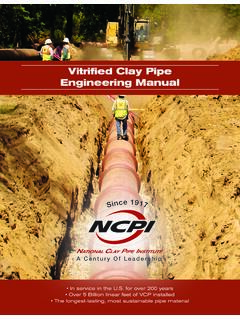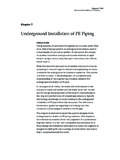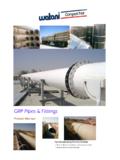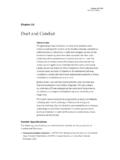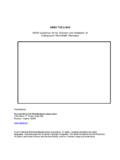Transcription of Uniform Soil Groups for Pipe Installation - NCPI
1 1 2014 UPDATES TO ASTM C12 Jeff Boschert, , MASCE and Amster Howard2, MASCE, 1 National Clay pipe Institute, President; Chesterfield, MO 63017; PH (314) 229-3789 email: 2 Consultant, Lakewood, CO 80228; PH (303) 989-5187 email: ABSTRACT The ASTM standard C12 Standard Practice for Installing Vitrified Clay pipe Lines gives recommended methods for installing vitrified clay pipe (VCP). C12 was significantly modified for the 2014 version (C12-14). Three of the most notable changes were: Use of uncompacted soil for the bedding Adoption of Uniform soil Groups Recommended gradation for the bedding soil The current standard includes several bedding classes for proper support of the pipe with corresponding Load Factors. The Load Factors reflect the amount of support the bedding soil gives to the Installation . While the basic trench configurations and Load Factors have not changed, the 2014 version incorporates various improvements including: Discontinuation of the concrete arch bedding class Adoption of Uniform Soil Groups for pipe Installation Recommendation for methods of improving the foundation to provide proper support for the pipe when the foundation is deemed not suitable Updates to bedding standards, including: o Use of uncompacted soil for the bedding o Recommended gradation for bedding soils o Specifying the appropriate amounts of fractured faces for Class II soil particles o Limiting the maximum soil particle size for bedding and initial backfill materials to 1-inch and 1 -inch particles.
2 Requiring shovel slicing of haunch area soil to occur before the bedding height is of the outside diameter of the pipe . Replacing subjective language with more definitive language ASTM specialized standards relating specifically to Controlled Low Strength Materials (CLSM) bedding for VCP In 1995, C12 became the first pipe Installation standard to give CLSM bedding as a viable option. Requirements for flowability when placed, 28 day compressive strength, and set time prior to backfill load are now referenced to the ASTM CLSM 2 standards. One advantage of using VCP is that it will not float during CLSM Installation . INTRODUCTION One hundred years ago, in 1915, ASTM C12 was issued. Finally adopted in 1919, this standard has undergone countless revisions since. The standard was significantly modified in 2014 (C12-14). The 2014 update incorporates the following improved Installation requirements and techniques: 1- Discontinuation of the concrete arch bedding class.
3 2- Adoption of Uniform Soil Groups for pipe Installation . 3- Recommendation for methods of improving the foundation to provide proper support for the pipe when the foundation is deemed not suitable. 4- Updates to bedding standards, including: a. Use of uncompacted soil for the portion of the bedding that the pipe is laid on. b. Recommended gradation for bedding soils. c. Specifying the appropriate amounts of fractured faces for Class II soil particles. d. Limiting the maximum soil particle size for bedding and initial backfill materials to 1-inch and 1 -inch particles, depending upon the bedding class. 5- Requiring shovel slicing of haunch area soil to occur before the bedding height is of the outside diameter of the pipe . 6- Replacing subjective language. 7- Adopted ASTM standards relating specifically to CLSM. Trench Cross Section Figure 1 illustrates the terms that are used throughout this paper and in connection with the changes to the ASTM standard. Figure 1: Trench Cross Section Terminology (Class C shown) 3 Bedding Classes Class D, C, B, and Crushed Stone Encasement The previous standard included several bedding classes for proper support of the pipe with corresponding load factors.
4 The currently recognized bedding classes are shown in Figure 2. The load factors reflect the amount of support the bedding soil gives to the Installation ( pipe bearing strength X load factor = field supporting strength). While the basic trench configurations and load factors have not changed, the references to type of soil used in the various areas have changed to use Uniform soil group nomenclature. The soil Groups are defined in Table 1 on page 4. DISCONTINUED USE OF CLASS A CONCRETE ARCH Until the 2008 version of C12, Class A bedding was defined using two Installation details, a concrete cradle and a concrete arch. The Class A concrete arch is no longer recommended and older specifications that include this option should be updated. The concrete arch was discontinued because any settlement of the bedding soil beneath the arch had the potential to increase the load on the pipe . Additionally, the settlement could result in a point load at the contact of the concrete arch on the top of the pipe .
5 ASTM C12 continues to recognize two viable concrete bedding classes, concrete cradle and full concrete encasement. Figure 2: VCP Bedding Classes Class D through Crushed Stone Encasement 4 Table 1: Uniform Soil Groups for pipe Installation Uniform SOIL Groups The soil Groups used in each bedding class are defined in Table 1. The soils are grouped according to strength required for pipe support (Howard 2009). This table has been incorporated into many ASTM standards and AWWA manuals and is now included in C12. The additional soil requirements for VCP installations, such as gradation and particle angularity were added. Uniform Soil Groups for pipe Installation1 Soil Class Definition USCS Symbols Class I2 Crushed Rock - 100% passing 1-1/2 in. (38 mm) sieve - </= 15% passing #4 sieve - </= 25% passing 3/8 in. ( mm) sieve - </= 12% passing #200 sieve Class II3 Clean, Coarse Grained Soils - Any soil beginning with one of these symbols (can contain up to 12% fines) - Uniform fines sands (SP) with more than 50% passing a #100 sieve should be treated as Class III material GW, GP, SW, SP Class III Coarse Grained Soils With Fines - Any soil beginning with one of these symbols GM, GC, SM, SC Sandy or Gravelly Fine Grained Soils - Any soil beginning with one of these symbols, with >/= 30% retained on #200 sieve ML, CL Class IV Fine-Grained Soils - Any soil beginning with one of these symbols, with < 30% retained on a #200 sieve ML, CL Class V4 Fine-Grained Soils, Organic Soils - High compressibility silts and clays, organic soil MH, CH, OL, OH, Pt 1 Soil Classification descriptions and symbols are in accordance with ASTM D2487 and ASTM D2488 2 For Class I, all particle faces shall be fractured.
6 3 Materials such as broken coral, shells, slag, and recycled concrete (with less than 12% passing a #200 sieve) should be treated as Class II soils. 4 Class V soil is not suitable for use as a bedding or initial backfill material. 5 FOUNDATION Trench load design for all pipe is based upon a firm and unyielding foundation. It is essential that the trench bottom remain stable during backfilling and under all subsequent trench operations. The foundation is critical to the performance of the entire pipe Installation . The foundation must be firm and unyielding as it needs to support the bedding, pipe and backfill. In cases where the trench bottom is soft and unsuitable to support the pipe , bedding and backfill; removal of material is necessary. Replacement can be accomplished with crushed rock or a woven geotextile fabric or both, to stabilize the foundation. Consult a Geotechnical engineer for other design methods to ensure the foundation supports the load. The native material in the trench bottom must be capable of excavation to a Uniform undisturbed flat bottom for a Class D Installation .
7 If the trench is over-excavated, the trench bottom should be brought back to grade with the required bedding material. BEDDING Uncompacted Bedding A layer of uncompacted bedding beneath the pipe is now included for Class B and Crushed Stone Encasement. The weight of the pipe , the fluids in the pipe , and the backfill help the pipe settle into the uncompacted layer and create a small bedding angle for support. This settlement also mobilizes the strength of the haunch support. The use of uncompacted bedding is an acceptable and recognized technique as evidenced by its inclusion in many ASTM standards and AWWA manuals. Accordingly the following statement was added to Section 9 Bedding under Construction Techniques: The portion of the bedding directly beneath the pipe and above the foundation should not be compacted for Class B and Crushed Stone Encasement. Gradation The bedding soil shall be cohesionless soils, Class I or Class II. The gradation for Class I and Class II soil for Class C bedding shall have a maximum particle size of 1 in.
8 (25 mm). The gradation for Class I and Class II soil for Class B bedding, Crushed Stone Encasement, and CLSM bedding shall be as follows: 100% passing a 1 in. (25 mm) sieve 40-60% passing a 3/4 in. (19 mm) sieve 0-25% passing a 3/8 in. ( mm) sieve 6 Particle Shape Class II soils shall have a minimum of one fractured face. For Class B, Crushed Stone Encasement, and CLSM installations where high and/ or changing water tables are present, the composition of materials shall be as follows: - 100% of the material shall have at least one fractured face, - 85% of the material shall have at least two fractured faces, - 65% of the material shall have at least three fractured faces. The percent of fractured faces should be determined in accordance with ASTM D5821. Because the particles are 100% fractured, Class I material is considered to be more stable and provides better support than Class II material that may have some rounded edges. HAUNCHING Proper haunch support (Figure 3) is necessary for the achievement of the load factor and thus, the structural integrity of the pipe .
9 Lack of proper haunch support is one of the most common causes of any pipeline failure. Haunch support depends on three factors: 1. Proper compaction of the bedding materials in the pipe haunches 2. Mobilization of the bedding within the limits of the haunch area 3. Bell or coupling holes/ pipe barrel Uniform support Compaction Of Haunch Soil Compaction of the soil in the haunch area significantly increases the support for the pipe . Gravels and crushed rock dumped into a trench beside the pipe result in minimum densities of the soil, which is about 80-85% of their maximum density. Compacting the soil to about 95% (ASTM D4253 Standard Test Methods for Maximum Index Density and Unit Weight of Soils Using a Vibratory Table) can increase the stiffness (modulus) of the soil 300 to 600% (Howard 2015). All bedding material shall be shovel-sliced so the material fills the haunch area and supports the pipe to the limits shown in the trench diagrams. Shovel-slicing the bedding material in the haunch areas is critical.
10 It takes little time, maintains grade, eliminates voids beneath the pipe and in the haunch areas, consolidates the bedding, and adds little or nothing to the cost of the Installation . To be the most effective, and to meet the requirements of C12, shovel slicing should be done before the bedding is no higher than the quarter point of the pipe , as illustrated in Figure 4. Shovel-slicing the bedding material into the haunches of the pipe is essential if the total load factor of the bedding class is to be realized. Appropriate shovel slicing technique is demonstrated in Figure 5. Figure 3: pipe Haunch Areas Bc = the outside diameter of the pipe . Bd = the design trench width measured at the horizontal plane at the top of the pipe barrel. 7 Increased Haunch Support By Soil Mobilization Haunch support for pipe can be effectively actuated by providing an uncompacted bedding for the pipe . The weight of the pipe , fluid in the pipe , and the backfill soil over the pipe help push the pipe into the uncompacted material creating a small cradle.
